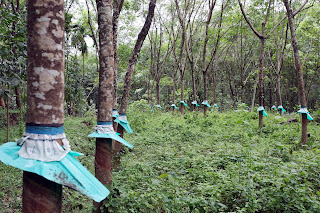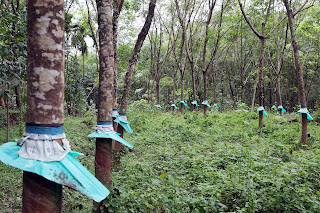A Journey through Kerala’s Lush Rubber Plantations
#Kerala #Rubber #Plantations
Have you ever
travelled through the verdant countryside of Kerala, India? Imagine lush green
rows of trees stretching as far as the eye can see, each with a unique, precise
incision on its bark. This, my friends, is a rubber plantation!
During a visit
to a friend’s residence in the depths of Kerala’s Kottayam district, I
encountered this captivating sight for the first time. Curiosity piqued, I
learned that these were rubber trees, the source of the natural latex that
forms the foundation of countless everyday products.
A Tropical
Paradise for the Rubber Tree
Rubber trees
thrive in the warm embrace of tropical regions like Southeast Asia, Africa, and
South America. They flourish in deep, fertile soil with a slightly acidic pH,
basking in the sunshine of temperatures ranging from 25-34 degrees Celsius with
high humidity.
Nurturing the
Golden Sap
Cultivating
rubber is a labor of love. These trees require meticulous care, including
protection from pests, weeds, and diseases. Skilled tappers, using a
specialized technique, extract the precious latex, a milky white sap, by making
precise incisions on the bark.
This
labor-intensive process is often carried out by smallholder farmers who manage
a staggering 85% of the world’s rubber plantations. Thailand currently reigns
supreme as the world’s largest producer of natural rubber.
Natural vs.
Synthetic: A Tale of Two Rubbers
Natural rubber,
extracted from the latex of the Hevea brasiliensis tree (though over 2500 other
plant varieties also produce latex), boasts exceptional water resistance,
resilience, and stretchability. However, synthetic rubber, derived from
petroleum, has also become a significant player in the market.
A Green Giant
with a Houseplant Cousin
While
large-scale rubber farming provides a significant income source for many
smallholders, it’s susceptible to price fluctuations. Interestingly, the rubber
plant also has a domesticated cousin – the easy-care houseplant! You can even
propagate your own rubber tree through air layering or stem cuttings.
Kerala: The
Crown Jewel of Indian Rubber Production
Kerala, with
its lush, hilly regions, proudly holds the title of India’s leading natural
rubber producer, contributing over 90% of the country’s output. Districts like
Kottayam, Kollam, Ernakulam, and Kozhikode are the heart of this production.
A Glimpse into
the Rubber Tapping Process
Imagine an
expert tapper meticulously creating an incision on the rubber tree’s bark.
Under the cloak of night, a small pot is attached to collect the latex that
flows freely. By morning, the pot brims with this valuable liquid gold. This
process is then repeated on the opposite side of the bark, ensuring a
sustainable harvest.
Planting the
Seeds for a Bountiful Future
Cultivating a
rubber plantation is a multi-step process:
1.
Land Preparation: Clearing and plowing the land, especially in hilly areas, is the first
step.
2.
Nurturing Seedlings: Seeds are grown in nurseries until they reach a suitable size for
grafting with buds from high-yielding varieties.
3.
Planting and Maintenance: The trees are planted in rows with a specific spacing
between them, and meticulous care is taken to protect them from pests, weeds,
and diseases. Regular fertilization ensures optimal growth.
4.
Harvesting: Once the trees
reach the age of seven, harvesting begins under the watchful eyes of skilled
tappers.
Kerala’s Rubber
Legacy
Kerala’s rubber
plantations are a testament to the state’s rich agricultural heritage. These
verdant rows not only contribute significantly to India’s economy but also
paint a picturesque landscape that captures the essence of Kerala’s natural
beauty.
In pictures rows of rubber plants in
Kottyam district of Kerala.
Picture Credit: Ashok Karan, Ashokkaran.blogspot.com
Please like,
share and subscribe. Thanks




Leave a Reply